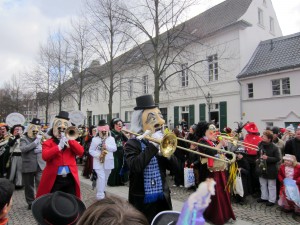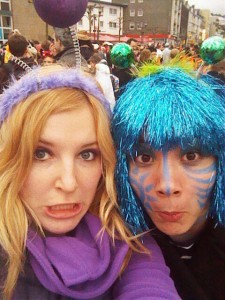From Carnival to Karneval
While studying abroad in France, I had the great opportunity to hop the country border over to Germany to go visit my cousins in Dusseldorf and celebrate Karneval with them. This was an especially interesting experience for me because I took a course called “From Carnival to Carnivalesque” from Prof. Robert Barsky last semester, and ever since then I haven’t been able to stop comparing things to the Carnival.

During the course, we read Gargantua by Francois Rabelais and a book about the origins of the carnival. Essentially, Rabelais’s novels portray a time period — pre-Renaissance Medieval era — during which the spirit of the carnival was at it’s prime. Carnival spirit equalizes people of varying statuses by bringing them all down to the same earthly vulgar level. We see this nowadays exemplified in Mardi Gras celebrations during which the Carnival King is meant to be the most disgusting, ugliest, most foul man…a perfect oxymoron of the ideal king. In the past, carnival would last as long as the 3 months after harvest when work was scarce…peasants, nobles, and clergy alike could be seen wandering the marketplace streets in search only of laughter, debauchery, and general raucous, if not violent, joy. The carnival is all about equalizing differences by bringing the high down, and raising the low to admirable levels. Jokes are made for the sake of laughter and not for the sake of sarcastic blows to the ego. Alcohol can be seen as a device to aid the equilibrium, mentally preparing people to accept equality. The carnival spirit survives in a world where anything goes, and everything and everyone is funny.

While, since the Rabelais’s time, there has been a severe disintegration of this spirit, but…it still survives on! Certainly, drugs and alcohol kind of bring about the same sentiment — but in a more selfish way…but definitely in celebrations such as Mardi Gras or Karneval! During my experience in Germany, I noted some key ingredients of Karneval that render it similar to the true carnival…these being 1) costumes, 2) alcohol, 3) street parades. The costumes allow everyone to disguise their true identity and class and mingle among anyone and everyone while also putting everyone at the same basic level of ridiculous costume-wearing-ness. The alcohol, on the other hand, mentally equalizes everyone and I don’t think I need to explain how. Finally, the street parades unite everyone in one very communal pedestrian area where children, teenagers, and adults alike call to the people on the floats in order to get candy thrown at them. Thus, these three factors equalize everyone no matter the class, the mental capacity, or the age of the participants. It is in this light that we can see, nowadays, the carnival spirit take form.
Oh, the joys of academic enlightenment!